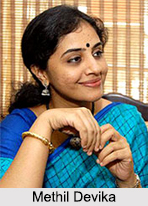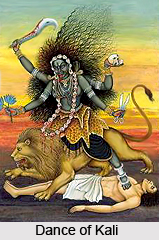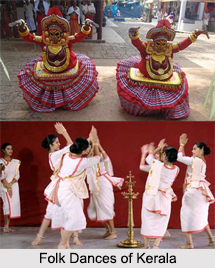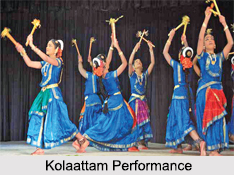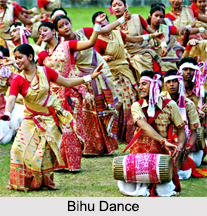 Folk Dances of North East India are mainly focussed on the dances of Arunachal Pradesh, Assam, Meghalaya, Manipur, Mizoram, Nagaland, and Tripura. Dance is the language of freedom of the soul and when it comes to the folk dances, the sky is enormous as the dances are devoid of the intricate grammar akin to the traditional and classical dance forms. Folk Dances of North East India thus unambiguously pinpoint the dance that is the symbol of the natural, unprompted and the spontaneous life of the common people.
Folk Dances of North East India are mainly focussed on the dances of Arunachal Pradesh, Assam, Meghalaya, Manipur, Mizoram, Nagaland, and Tripura. Dance is the language of freedom of the soul and when it comes to the folk dances, the sky is enormous as the dances are devoid of the intricate grammar akin to the traditional and classical dance forms. Folk Dances of North East India thus unambiguously pinpoint the dance that is the symbol of the natural, unprompted and the spontaneous life of the common people.
Different Folk Dances of North East India
North East India is known for its interesting culture and eclectic dance forms. Following are the Different Folk Dances of North East India:
Bihu Dance: This is a happy dance that is contributed by men as well as women. The Bihu Dance is a folk dance of Assam which is extremely connected to the festival of Bihu. All dancers dress in the traditional and colourful Assamese clothes that attach charm to the complete dance. The important features of the dance are subtle movements of the hips, wrists, arms along with squats and curves but with no jumps. The dance is executed along with beautiful Bihu Music.
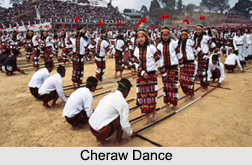 Zeliang Dance: The members of the "Zeliang" tribe let their women members to take part in dance along with the men. Zeliang is a unique dance form of Nagaland. The members enter the dance stage with some unusual movements that are characterized by the foot beating sounds. Dancers change their beats relatively in this dance and some unusual chants and hand clapping sounds punctuate the whole presentation.
Zeliang Dance: The members of the "Zeliang" tribe let their women members to take part in dance along with the men. Zeliang is a unique dance form of Nagaland. The members enter the dance stage with some unusual movements that are characterized by the foot beating sounds. Dancers change their beats relatively in this dance and some unusual chants and hand clapping sounds punctuate the whole presentation.
Hojagiri Dance: The Hojagiri dance is presented by "Riang" clan of Tripura tribes. Only women are permitted to participate in this Puja and there are 5-7 members in each dance team. It is normally performed on the propitious occasion of the Hojagiri Lakshmi Puja.
Pung Chalom Dance: This is a famous Manipuri Dance. This is an exclusive dance that is an introduction to the famous "Ras Lila Dance". Dancers move to the beat of the "pungi" which is a kind of hand operated drum. Acrobatics are performed without breaking the tempo of the dance.
Singhi Chham Dance: Singhi Chham is a type of masked dance presented in Sikkim. This dance centres on the Snow Lion which is the symbol of Sikkim. The Snow Lion is formally identified as the symbol of the state of Sikkim as ordered by spiritual Guru Padamsambhava. This beautiful dance is performed in the month of September and demonstrates a great depiction of Sikimese culture.
Nongkrem Dance: `Nongkrem` is an essential folk dance of Meghalaya. The "Khasi" tribe of Meghalaya celebrates the developing of paddy for threshing, by dances and songs. `Nongkrem` dance is performed in Meghalaya, during autumn.
Dhol-Cholom Dance: Dhol Cholom is a drum dance performed during Holi in Manipur. The dance is exciting and is performed by young men holding swords and shields.
Bagurumba Dance: Bagurumba is a folk dance of local "Bodo" tribe in Assam and Northeast India. It is a traditional dance which is by tradition natural from one generation to another. The "Bodo" women present the "Bagurumba" dance with their colourful "dokhna", "jwmgra" (fasra) and "aronai".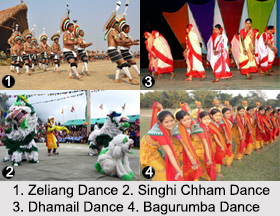
Cheraw Dance: Cheraw Dance is a chief attraction throughout all celebratory occasions in Mizoram. Cheraw dance is a blend of rhythm and skill. Four people hold two pairs of long bamboos across one another on the ground. As the bamboo sticks are clapped together, the chief dancers in customary attires weave patterns during them in time to the rhythm.
Chang Lo Dance: It was presented to rejoice the triumph over enemies in the earlier times. Currently, it forms a part of all the community celebrations, such as "Poanglem". There are theatrical costumes of the traditional Naga warrior and best clothes of womenfolk. The "Chang Lo" is a dance of the "Chang" tribe of Nagaland.
Laho Dance: Laho Dance is a folk dance of Meghalaya. People of Meghalaya particularly the "Pnar" Tribe, takes part in Laho dance with multi-coloured clothes. Two men stand in both side of a woman and they connect each other"s arms to present in particular steps.
Thang Ta Dance: It is mainly a martial art of Manipur. It includes sword, spear, dagger and other outer weapons along with inner practice of controlling own self. With the rhythm of breathing, soft movements are done by the dancers.
Bardo Chham Dance: It is a folk dance of Arunachal Pradesh. The dancers present a theatrical performance between these two units to convey joy and peace, wearing colourful masks. Both men and women join in this dance.
Dhamail Dance: Dhamail folk dance is an essential part of the Barak Valley culture. Dhamail dance is presented by a group of women. Women move in a circle clapping their hands to the beat of the music. The lyrics mostly relate to Krishna and Radha.
